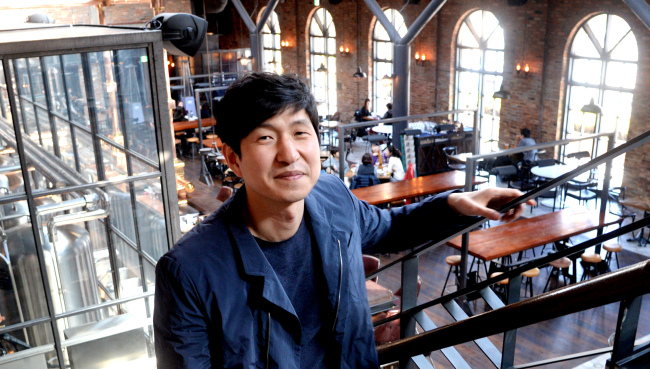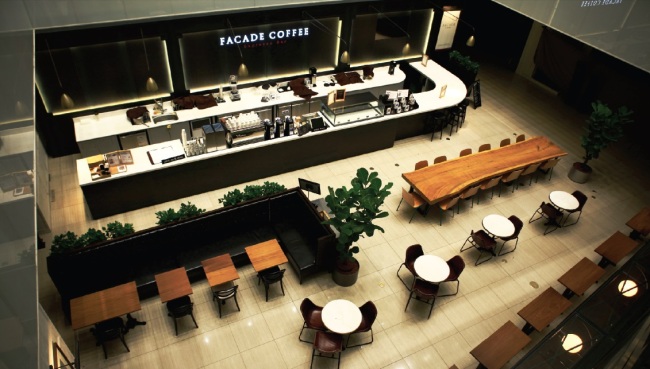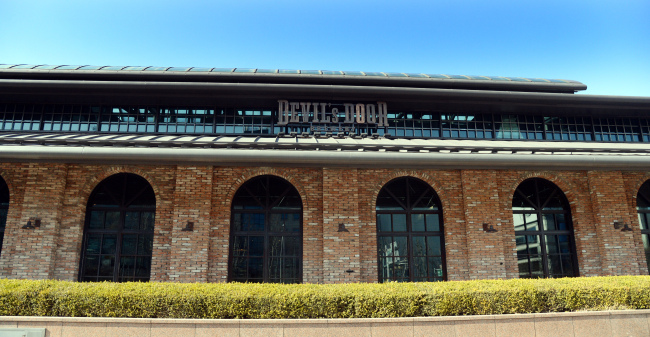The oversized, domineering gate of rusty steel topped by the nameplate Devil’s Door is never meant to make guests feel at ease. Inside, an awe-inspiring interior of the top-flying brewpub in southern Seoul welcomes beer lovers longing for new tastes, choice and experience.
The 10-meter-high ceilings, retro benches and chairs, brick wall art and a web of vintage metal pipe lamps combine to create the feel of a cottage brewery that has breathed a new life into an old abandoned factory in Brooklyn, New York. An open bar features the facility’s state-of-the-art brews brought in from Germany, while guests can even perform their own brewing experiments in a mini lab.
With the classy atmosphere and the meticulously thought-out decor, coupled with the soaring popularity of craft beer here, the brewery run by Shinsegae Food has become one of Seoul’s hottest spots for a night out. Four months into its opening, customers may have to brave a two-hour queue during the dinner rush, despite its some 1,300-square-meter space.
For Jung Sung-gyu, the chief executive and creative director of The Square Design Co. Ltd. who orchestrated its industrial facelift, the project brought about a turnaround in his 15-year career. One of the most talked about up-and-coming interior designers in Korea, the 42-year-old is now being courted by retail and food giants including AK Plaza, Namyang Dairy Products Co. and Sun at Food.
The 10-meter-high ceilings, retro benches and chairs, brick wall art and a web of vintage metal pipe lamps combine to create the feel of a cottage brewery that has breathed a new life into an old abandoned factory in Brooklyn, New York. An open bar features the facility’s state-of-the-art brews brought in from Germany, while guests can even perform their own brewing experiments in a mini lab.
With the classy atmosphere and the meticulously thought-out decor, coupled with the soaring popularity of craft beer here, the brewery run by Shinsegae Food has become one of Seoul’s hottest spots for a night out. Four months into its opening, customers may have to brave a two-hour queue during the dinner rush, despite its some 1,300-square-meter space.
For Jung Sung-gyu, the chief executive and creative director of The Square Design Co. Ltd. who orchestrated its industrial facelift, the project brought about a turnaround in his 15-year career. One of the most talked about up-and-coming interior designers in Korea, the 42-year-old is now being courted by retail and food giants including AK Plaza, Namyang Dairy Products Co. and Sun at Food.

“It was an adventure for Shinsegae to have me do that job given that the company works with major design houses and many renowned designers who dominate the industry, but I rather belong to the periphery,” he said in a recent interview with The Korea Herald.
“When I asked the company’s design chief why he hired me, he said, ‘It’s because you do all the work on your own, whereas big firms and designers would hand it over to their staff.’ So I tried hard not to let them down, and the chance ended up being a turning point in my life.”
His relationship with the nation’s top retail group dates back to 2012 when he designed a brunch restaurant named Egg Talks for a different subsidiary. He set up his own business in 2013 and now has a workforce of 15.


He started work on the Devil’s Door project in January 2014, and the design took almost a whole year. The sheer size of the space and details aside, a legislative amendment prompted him to spend four months designing smoking areas alone to satiate a Shinsegae executive’s desire for the “best smoking and restrooms in the country.”
“Jung’s design fit our concept ― our goal was to show production equipment in a factory-like setting. I think this is what captivates many customers; they love to make beer on their own and drink it,” said Oh Jin-young, the pub’s brewmaster.
Following a years-long sweep of Scandinavian styles, the interior design world is witnessing an ascent of industrial concepts. Its raw, seemingly incomplete look and neutral tones increasingly entice those who cherish the function of objects as much as style.
The Scandinavian concepts propelled the beginning of the emergence of “rawness,” Jung said, closing what he called the era of instant design. The fresh fad caters to the people’s growing needs for the natural, unrefined.
“It’s equivalent to not wanting any more instant coffee and junk food; communicating with space is just like tasting food,” he said. “People love to read others’ blogs and watch Afreeca TV. That’s today’s trend ― to communicate with raw stuff.”
Powered by the stellar success of Devil’s Door, 2015 is set be one of his busiest years yet, with his company carrying out projects ranging from cafes to restaurants to hotels.
Among them are a Facade Coffee espresso cafe to be launched later this year at AK Plaza’s Suwon branch in Gyeonggi Province; Namyang’s upcoming homemade teriyaki restaurant called From the Farm in Pangyo, Seongnam, Gyeonggi Province; a new Sun branch at Food’s Sichuan House in southern Seoul; and a tourist hotel in Jeju.
Jung in particular is mesmerized by hotels as they combine various elements such as lodging, restaurants, cafes and often a wedding hall and convention center. Newly opened boutique hotels in Jeju designed by him, namely Grabel and La Mer, are gaining popularity among travelers from home and abroad.
“Hotels and restaurants need to be conceptual and have good storytelling, for which it is crucial to have an objective viewpoint so as to appeal to a large audience. For homes, in contrast, satisfying your client in each component is key,” he said.
While basking in the steady growth of Korea’s interior design industry, he is turning his sights overseas. In Hong Kong and Singapore, for instance, markets are seeing growing needs and designers are given greater leeway in their creative work, he said. Jung secured a few projects in Indonesia but all of them were from Koreans.
To him, design is just like human beings. After all, it’s all about building relationships between different entities, and the patience and resolve to prop them up.
“Design is difficult, or probably impossible, to define. Once you define it, you may be trapped in that definition and create bias,” Jung added.
“Just like every person differs from one another, every space has its own character and room for different expression. There cannot be twins.”
By Shin Hyon-hee (heeshin@heraldcorp.com








![[Graphic News] More Koreans say they plan long-distance trips this year](http://res.heraldm.com/phpwas/restmb_idxmake.php?idx=644&simg=/content/image/2024/04/17/20240417050828_0.gif&u=)
![[KH Explains] Hyundai's full hybrid edge to pay off amid slow transition to pure EVs](http://res.heraldm.com/phpwas/restmb_idxmake.php?idx=644&simg=/content/image/2024/04/18/20240418050645_0.jpg&u=20240419100350)





![[From the Scene] Monks, Buddhists hail return of remains of Buddhas](http://res.heraldm.com/phpwas/restmb_idxmake.php?idx=652&simg=/content/image/2024/04/19/20240419050617_0.jpg&u=20240419175937)

![[KH Explains] Hyundai's full hybrid edge to pay off amid slow transition to pure EVs](http://res.heraldm.com/phpwas/restmb_idxmake.php?idx=652&simg=/content/image/2024/04/18/20240418050645_0.jpg&u=20240419100350)

![[Today’s K-pop] Illit drops debut single remix](http://res.heraldm.com/phpwas/restmb_idxmake.php?idx=642&simg=/content/image/2024/04/19/20240419050612_0.jpg&u=)